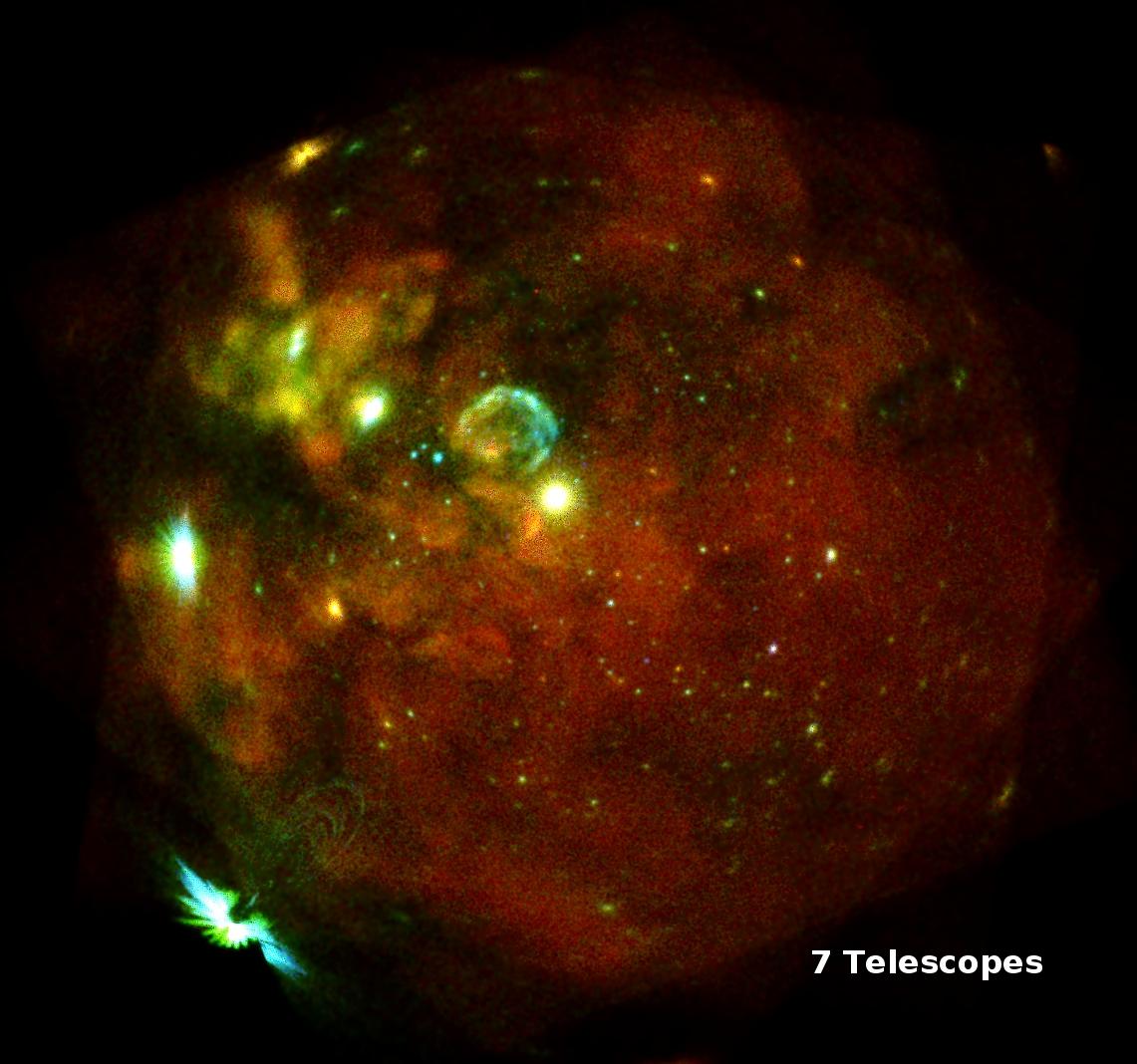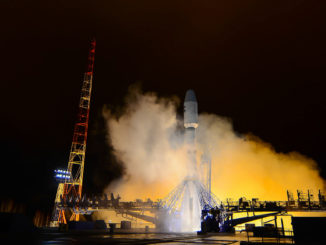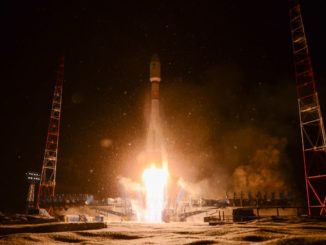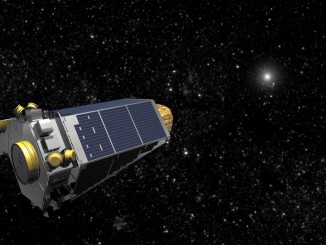
Astronomers are elated with the first X-ray images from a German telescope on Russia’s Spektr-RG astronomy mission, demonstrating the instrument’s ability to observe galaxies near and far as scientists seek answers to questions about dark energy.
German officials released the “first light” images from the eROSITA instrument Tuesday. The German-built instrument is the primary payload on the Russian Spektr-RG X-ray astronomy observatory, which launched in July on a Proton rocket and headed for an observing post nearly a million miles (1.5 million kilometers) from Earth.
“These first images from our telescope show the true beauty of the hidden universe,” said Peter Predehl, principal investigator of eROSITA from the Max Planck Institute for Extraterrestrial Physics, or MPE. “To meet our science goals, we needed enough sensitivity to detect the most distant clusters of galaxies in the universe over the whole sky, and resolve them spatially. These first light images show that we can do exactly that, but we can go a lot further.”
Scientists performed the first observations with eROSITA, which stands for the ROentgen Survey with an Imaging Telescope Array, between Oct. 17 and Oct. 19, officials said.
One of the images released Tuesday shows the Large Magellanic Cloud, a satellite galaxy of our Milky Way, and another shows a pair of galaxies located 800 million light-years away. The images come from a series of exposures using seven individual X-ray mirror modules inside eROSITA.
Clouds of super-hot gas — visible to an X-ray telescope but not to a telescope observing in visible light — dominate the the eROSITA image of the Large Magellanic Cloud. Among other bright light sources, the image shows the bright remnant left behind by a supernova explosion detected in 1987 is getting fainter.
“This is a pivotal moment in the life of the telescope, as this is when we see for the first time how good the overall system really is,” said Thomas Mernik, eROSITA’s project manager at DLR, the German space agency. “With its observations of the Large Magellanic Cloud, eROSITA has demonstrated its capabilities to impressive effect. We have obtained razor-sharp images with remarkably little background noise. These first impressions allow us to anticipate great things over the coming years.”
Other X-ray telescopes, such as the European Space Agency’s XMM-Newton observatory, have observed the Large Magellanic Cloud.
“The direct comparison with earlier images shows the true performance of eROSITA. XMM-Newton mainly observes specially selected objects and therefore sees them in great detail,” Mernik said. “eROSITA also provides detailed images — but will study the entire hot universe.”
The eROSITA telescope is a follow-up to the German ROSAT mission, which launched in 1990 and conducted the first all-sky X-ray imaging survey. Besides eROSITA, the Spektr-RG mission carries a Russian instrument named ART-XC, which uses X-ray mirror modules fabricated at NASA’s Marshall Space Flight Center in Alabama.
Data from eROSITA’s all-sky survey could act as a roadmap for Chandra and future X-ray missions to pursue targeted observations. Spektr-RG is designed to operate at least seven years, with four years dedicated to the all-sky survey — with one full-sky scan every six months — followed by three years of pointed observations to follow up on specific targets.
“X-rays give us a unique view of the Universe, hidden in visible light,” said Kirpal Nandra, director of high energy astrophysics at MPE. “Looking at an apparently normal star, in X-rays we might see an orbiting white dwarf or neutron star in the process of devouring its companion. Visible light shows the structure of a galaxy traced by its stars, but the X-rays are dominated by supermassive black holes growing at their centers.
“And where we see clusters of galaxies with optical telescopes, X-rays reveal the huge reservoirs of gas filling the space between them and tracing out the dark matter structure of the universe,” Nandra said. “With its performance demonstrated, we now know that eROSITA will lead to a breakthrough in our understanding of the evolution of the energetic universe.”
While the Large Magellanic Cloud is in our cosmic neighborhood — around 170,000 light-years away — eROSITA also peered deeper into the universe to observe a pair of much more distant galaxies.

The observations of two interacting galaxy clusters illustrate the imaging power of eROSITA, which is designed to detect and map massive structures throughout the universe. The observations will help astronomers and cosmologists chart how mass is distributed throughout the universe, which will better constrain models about the nature of dark energy.
Dark energy is the term ascribed by cosmologists for the hidden force that drives the accelerating expansion of the universe. Scientists believe dark energy represents about 70 percent of the energy density of the universe, with dark matter — matter that exerts a gravitational attraction but emits no light — making up about 25 percent of the universe, according to NASA.
Scientists say ordinary matter — stuff we can see — makes up only about 5 percent of the universe.
Gravitational bonds bring together galaxies into groups and clusters along gigantic filaments of hot gas detectable with X-ray telescopes. The eROSITA instrument will find and map up to 100,000 galactic clusters during its mission.
“Since eROSITA will help us to better understand the dynamics of the largest structures in the universe, we could also learn more about cosmic expansion,” Mernik said. “This means that eROSITA will provide us with the data needed to get closer to solving the puzzle of dark energy.”
The Spektr-RG spacecraft completed a 100-day cruise to an observing location in orbit around the sun-Earth L2 Lagrange point Monday.
The commissioning of the eROSITA instrument hit a snag after the mission’s launch July 13. Electronics in some of eROSITA’s telescope modules malfunctioned, according to DLR.
“The commissioning phase lasted longer than expected, after we found some anomalies in the electronic controls of the cameras,” Predehl said. “But teasing out these problems is exactly why we have such a phase. After a careful analysis we determined that the issues are not critical. We’re still working on them, but in the meantime the program can go forward normally.”
Ground teams will uplink commands to capture more test images in the next few weeks, before the eROSITA instrument proceeds into a regular observing campaign.
“The potential for new discoveries is immense,” Predehl said. “Now we can start reaping the fruits of more than ten years of work.”
Email the author.
Follow Stephen Clark on Twitter: @StephenClark1.



